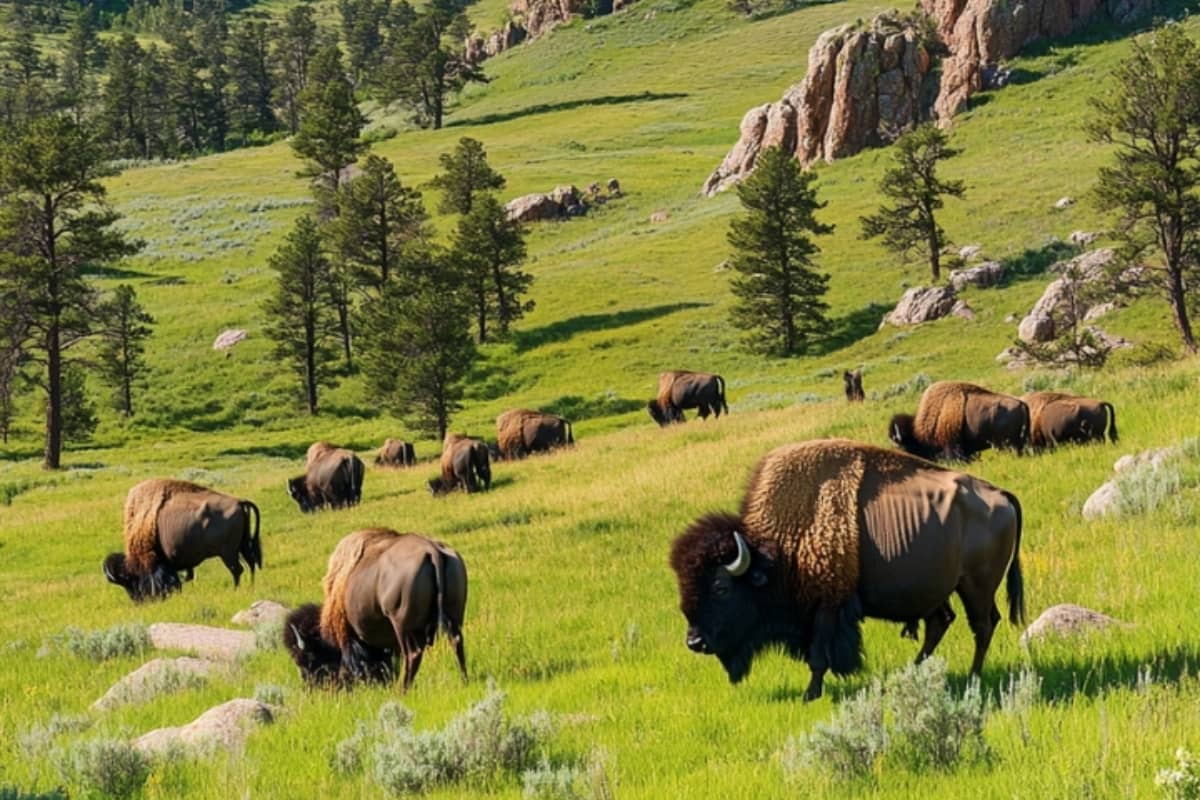Custer State Park in the Black Hills of South Dakota offers visitors a glimpse of the state’s natural beauty with its scenic drives, hiking trails, and abundant wildlife. However, like many popular outdoor destinations, the park hides potential dangers that can catch tourists off-guard. While it remains a captivating place for exploration, understanding and preparing for these hidden hazards can ensure a safer and more enjoyable experience. This article delves into the six hidden dangers at Custer State Park and offers insights on how to mitigate them.
1. Wildlife Encounters: Respect the Animals
Custer State Park is famous for its wildlife, particularly its bison herds that roam freely across the park’s prairies and roads. While the sight of these majestic creatures is undoubtedly thrilling, bison can pose serious threats if visitors don’t maintain a safe distance. These massive animals are unpredictable and can become aggressive when they feel threatened. Each year, incidents involving bison charging at visitors make headlines. Experts recommend keeping at least 100 yards between yourself and any large wildlife, including bison, elk, and mountain goats.
Similarly, while the park’s wild burros—descendants of the pack animals once used for transporting visitors—are known for their friendly demeanor, they remain wild animals. Visitors often make the mistake of feeding them, leading to aggressive behavior. Feeding wildlife, apart from being dangerous, disrupts their natural habits and is prohibited within the park.
2. Navigating the Park’s Scenic Drives: A Beautiful but Treacherous Journey
The park’s scenic routes, such as the Needles Highway and Iron Mountain Road, are among its most popular attractions, offering stunning views of rock formations, tunnels, and wildlife. However, these roads are narrow, with sharp curves and switchbacks, posing challenges to inexperienced drivers. The Needles Highway, for example, passes through narrow tunnels, with barely enough room for vehicles to pass, which can be nerve-wracking for some. The sharp twists and elevation changes, especially on Iron Mountain Road, require careful attention. While the scenery is breathtaking, drivers must be cautious, particularly around blind corners and wildlife crossings.
For those embarking on these scenic drives, reducing speed and remaining alert are essential for avoiding accidents. Additionally, visitors should check their vehicles before the drive to ensure they can handle the challenging terrain.
3. Unpredictable Weather: Be Prepared for the Elements
Sudden changes in weather are a common occurrence in Custer State Park, especially in higher elevations like Black Elk Peak and Sylvan Lake. Thunderstorms can quickly roll in during the summer months, bringing heavy rain, lightning, and strong winds. Hikers often find themselves caught in unexpected storms, leading to slippery trails and dangerous conditions.
The temperature can also drop rapidly, particularly in the evenings, even during warmer months. Hypothermia is a real threat for those unprepared for cooler weather. Hikers should carry weather-appropriate clothing and monitor weather forecasts closely. Packing rain gear and extra layers, even on seemingly sunny days, can make a big difference in ensuring safety while exploring the park.
4. Hiking Hazards: Rocky Trails and Steep Ascents
Custer State Park boasts several hiking trails that attract adventurers, from beginners to seasoned hikers. However, some of the park’s most popular trails, like Black Elk Peak, Cathedral Spires, and Lovers Leap, present challenges that visitors may underestimate. These trails often feature uneven, rocky terrain, steep ascents, and, in some areas, require scrambling over boulders. The risk of injury from falls is significant, particularly for those unfamiliar with such rugged trails.
Hiking in the park requires proper preparation. Visitors should wear appropriate footwear, carry enough water, and avoid hiking in areas they are unprepared for. It’s also crucial to stay on marked trails, as venturing off can lead to disorientation and dangerous terrain.
5. Wild Burros: Friendly but Feisty
Among Custer State Park’s most beloved residents are the wild burros that roam freely and frequently approach vehicles for food. While they are charming and appear friendly, feeding them is a dangerous habit. It not only encourages the animals to become dependent on human food but can also lead to aggressive behavio.
The burros may block traffic on the Wildlife Loop, posing hazards to both drivers and animals. Keeping your distance, not feeding the burros, and being patient while driving can help prevent potential accidents. The park enforces a strict no-feeding policy, emphasizing that the burros, though tame in appearance, are still wild animals that should not be disturbed.
6. Fire Hazards: Protecting the Park’s Ecosystem
South Dakota, particularly during its dry summer months, is susceptible to wildfires. Custer State Park, with its dense forests and grassy plains, is no exception. In December 2017, a wildfire tore through the park, burning over 50,000 acres and threatening wildlife and human safety. The park has since implemented stricter fire safety regulations to prevent similar disasters.
Campfires are only allowed in designated areas, and visitors should adhere strictly to fire safety protocols. Extinguishing campfires completely before leaving and avoiding smoking in prohibited areas can help reduce the risk of fire. Additionally, visitors should remain vigilant during times of heightened fire danger, paying attention to park alerts and following any fire restrictions in place.
Conclusion
Custer State Park remains one of the most beautiful and diverse destinations in the United States, attracting visitors with its scenic beauty, abundant wildlife, and outdoor activities. However, it’s crucial to be aware of the hidden dangers that can quickly turn a thrilling adventure into a dangerous situation. From wildlife encounters and hazardous roads to unpredictable weather and fire risks, understanding and preparing for these potential threats can ensure a safer visit to the park. By respecting the park’s wildlife, being cautious on its scenic drives, and preparing for weather and trail conditions, visitors can fully enjoy the magic that Custer State Park has to offer while staying safe.






